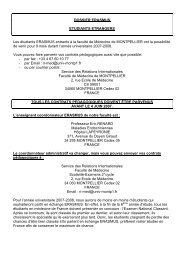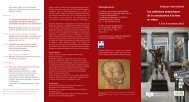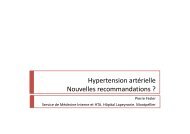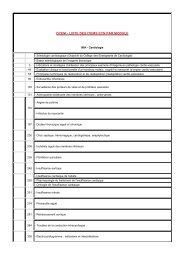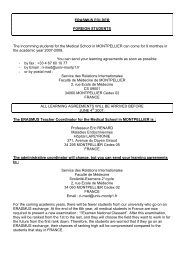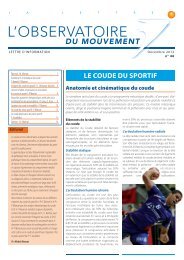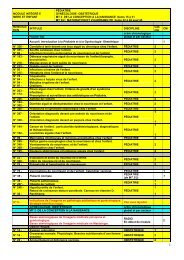Diabète Instable - Faculté de médecine de Montpellier
Diabète Instable - Faculté de médecine de Montpellier
Diabète Instable - Faculté de médecine de Montpellier
You also want an ePaper? Increase the reach of your titles
YUMPU automatically turns print PDFs into web optimized ePapers that Google loves.
<strong>Diabète</strong> <strong>Instable</strong>:<br />
Comment le comprendre et l’Améliorer ?<br />
1 portion = 10g <strong>de</strong> gluci<strong>de</strong>s<br />
2 portions = 20 g <strong>de</strong> gluci<strong>de</strong>s 3 portions = 30 g <strong>de</strong> gluci<strong>de</strong>s<br />
Denis G … 23 ans, étudiant en gestion, HbA1c 8,5%<br />
Restauration rapi<strong>de</strong> ou sandwich à midi, collations épisodiques dans l’après-midi,<br />
travaille très tard, dîne encore plus tard, le plus souvent au restaurant …. Pas <strong>de</strong> sport<br />
2 portions = 20 g <strong>de</strong> gluci<strong>de</strong>s<br />
4 portions = 40 g <strong>de</strong> gluci<strong>de</strong>s 5 portions = 50 g <strong>de</strong> gluci<strong>de</strong>s<br />
Lever Insuline PP Midi Insuline PP Dîner Insuline Coucher<br />
Insuline<br />
Lantus<br />
Lundi 2.05 11 0.67 8 1.30 9 1.27 24<br />
Mardi 0.99 9 1.13 9 3.29 2.28 11 3.07 24<br />
Mercredi 2.45 11 1.02 9 1.75 10 1.53 24<br />
Jeudi 1.38 9 2.97 1.59 9 1.41 0.92 9 2.93 24<br />
vendredi 2.07 11 2.12 11 1.08 9 3.33 24<br />
Défaut <strong>de</strong> correction <strong>de</strong> la dose<br />
d’insuline en fonction <strong>de</strong> la<br />
glycémie pré-prandiale<br />
Utilité <strong>de</strong> l’apprentissage <strong>de</strong> la compensation<br />
(ou correction glycémique)<br />
• Le calcul permet <strong>de</strong> définir pour un patient donné, le<br />
pouvoir hypoglycémiant d’une unité d’analogue rapi<strong>de</strong>. Par<br />
exemple, pour un patient normalement sensible à<br />
l’insuline et pesant 60 kg, 1u diminuera la glycémie<br />
d’environ 0.35 g/l (ou 3u pour 1 g/l)<br />
• A tout moment ( à condition d’être à plus <strong>de</strong> 3 heures<br />
d’une injection d’analogue rapi<strong>de</strong>) la correction précise<br />
d’une hyperglycémie y est possible<br />
• Le plus souvent cette correction est effectuée au moment<br />
d’un repas, quand la glycémie est mesurée. La dose<br />
correctrice est ajoutée à la dose prévue pour le repas.<br />
Petit Exercice<br />
• Denis pèse 65 kg, sa dose d’insuline est <strong>de</strong> 1 u pour 10g <strong>de</strong><br />
gluci<strong>de</strong>s et 1u fait baisser sa glycémie <strong>de</strong> 0,40 g/l.<br />
• Denis choisit <strong>de</strong> manger :<br />
• 1 Big Mac<br />
• 1 Gran<strong>de</strong> Frite<br />
• 1 Coca-cola<br />
• 1 Esquimau<br />
• Sa glycémie est <strong>de</strong> 1,80 g/l avant le repas.<br />
• Il doit donc injecter ou faire un bolus <strong>de</strong>:<br />
• Calcul <strong>de</strong>s gluci<strong>de</strong>s: 1 Big Mac = 40 g + 1 Gran<strong>de</strong> Frite = 60 g +<br />
1 coca-cola = 40 g + 1 esquimau = 30 g<br />
Total repas = 170 g <strong>de</strong> gluci<strong>de</strong>s => 17 u d’insuline<br />
• Il doit corriger sa glycémie <strong>de</strong>: 1,80 – 1 = 0,80 g/l<br />
Total correction = 2 u d’insuline<br />
• Total Général = 17 + 2 = 19 u d’insuline<br />
11



